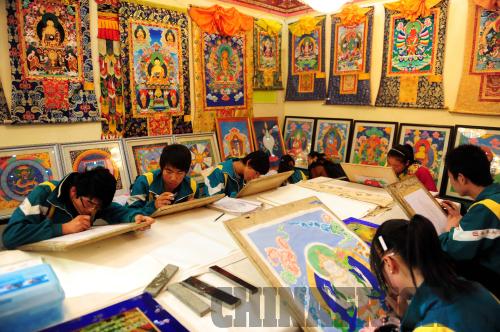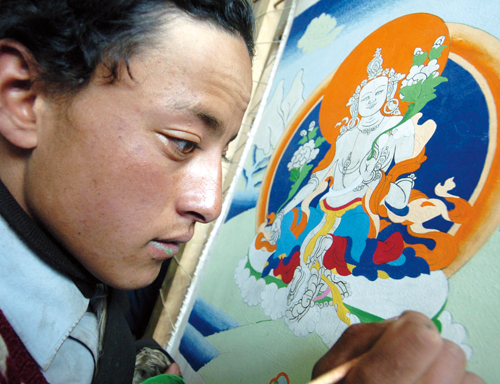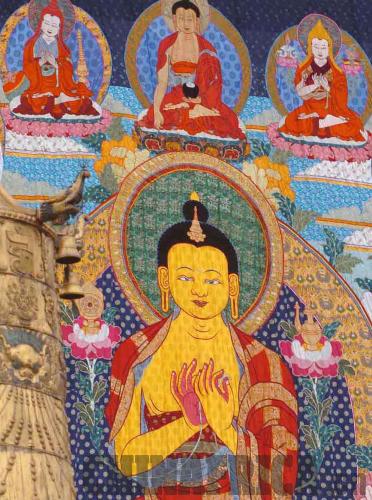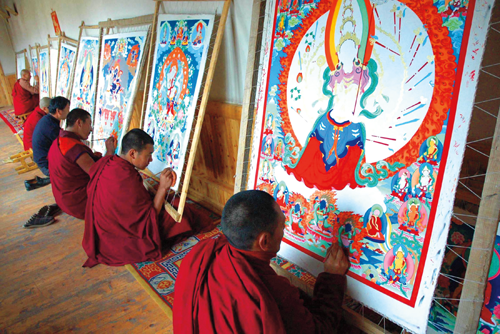|
 |
|
(NIE JIANJIANG) | Required course
As thangka painting requires delicate technique, collection of thangka paintings has been in vogue in recent years.
However, it is the piety of the painters that endows thangka with its unique charms, according to Pedma. "Without piety, even with exquisite skill, the painting would lose its sense and cultural foundation."
"It will take 10 years to cultivate a thangka painter," Pedma continued. "However, some painters begin to work independently after only two years' learning, and each of their paintings would be sold at a price of 2,000 yuan ($316)," he said.
Such quick learning resulted in a lack of creativity. Without piety and solid skills, such works have no soul in Pedma's opinion.
For Pedma's students, it is a required course to read and research sutras and use them to cultivate Buddhist virtues.
By day, students practice drawing techniques, and by night, they recite sutras with their teacher. The quiet courtyard is secluded and their austere lifestyle is advantageous to their craft.

Many people don't understand Pedma when he decided to open the class in Beijing, saying the religious atmosphere in Beijing would not be as strong as in Qinghai's Tongren County, known to Tibetans as Rebkong, where Buddhist monks and folk artists of the Tibetan and Tu ethnic groups create thangka, murals and sculptures, known collectively as the Rebkong arts.
"But in my opinion, it is a more suitable place for me to teach and do art in Beijing," said Pedma. "In Qinghai, students would be disturbed by household chores, so it is impossible for them to calm their minds to learn painting, not to mention study sutras. As the classroom is located in a quiet suburb, it is more suitable for us to calm our minds in the creative process," he told Beijing Review.
Over 1,300 years ago, strict guidelines for drawing the Buddha was defined in a sutra, which is one more difficulty for students. Drawing techniques may change with the times, but the proportions of the Buddha's features never do.
Only drawing in a meticulous way can one relay a vivid lifelike image of the Buddha.
"When drawing, painters must make full concentration with piety to Buddha, and keep in mind the Buddha's image. Before brush meets canvas, painters must learn by heart what religious objects are grasped in each hand. The painters also need to practice constantly for years," Pedma said.
 |
|
Thangka (JUE GUO) |
It takes all kinds
"We found that thangka art currently meets many difficulties in protection and inheriting when we made inspections to areas inhabited by Tibetans. The most outstanding problem is the lack of inheritors," said Pedma.
Slashed by commercialization and industrialization, many thangka painters find it hard to devote 10 years just to learning the basics.
"In the face of such situations we held training classes to provide an opportunity to further educate those talented students who are willing to learn the art of thangka, to cultivate them as inheritors of the art," said Pedma.
"For teachers, the classes will be a good platform to find talented students. For other students, even if they cannot become inheritors of the thangka tradition, they may learn some basic techniques and understand the art through studying here."
The operation of the class also helps make a change for the traditional inherit methods where women and laymen were forbidden to learn thangka.
According to Pedma, most thangka painters have been male, because they needed to go to temples to learn the art, and many of the techniques are passed down from their ancestors: if one's grandfather and father both painted, so will he.
Now, anyone has an opportunity to become a painter regardless of gender or family status, as long as he or she is talented, determined, pious and of calm mind. "My daughter is following me to study the thangka painting, and she is studying hard," said Pedma.

|